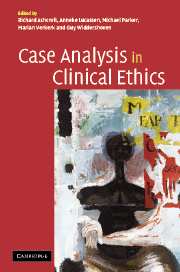Book contents
- Frontmatter
- Contents
- Notes on contributors
- Acknowledgements
- 1 Philosophical introduction: case analysis in clinical ethics
- 2 Families and genetic testing: the case of Jane and Phyllis
- 3 Family access to shared genetic information: an analysis of the narrative
- 4 A virtue-ethics approach
- 5 Interpretation and dialogue in hermeneutic ethics
- 6 ‘Power, corruption and lies’: ethics and power
- 7 Reading the genes
- 8 A utilitarian approach
- 9 A feminist care-ethics approach to genetics
- 10 A conversational approach to the ethics of genetic testing
- 11 Families and genetic testing: the case of Jane and Phyllis from a four-principles perspective
- 12 A phenomenological approach to bioethics
- 13 An empirical approach
- 14 Response to ethical dissections of the case
- 15 Philosophical reflections
- Index
- References
14 - Response to ethical dissections of the case
Published online by Cambridge University Press: 01 September 2009
- Frontmatter
- Contents
- Notes on contributors
- Acknowledgements
- 1 Philosophical introduction: case analysis in clinical ethics
- 2 Families and genetic testing: the case of Jane and Phyllis
- 3 Family access to shared genetic information: an analysis of the narrative
- 4 A virtue-ethics approach
- 5 Interpretation and dialogue in hermeneutic ethics
- 6 ‘Power, corruption and lies’: ethics and power
- 7 Reading the genes
- 8 A utilitarian approach
- 9 A feminist care-ethics approach to genetics
- 10 A conversational approach to the ethics of genetic testing
- 11 Families and genetic testing: the case of Jane and Phyllis from a four-principles perspective
- 12 A phenomenological approach to bioethics
- 13 An empirical approach
- 14 Response to ethical dissections of the case
- 15 Philosophical reflections
- Index
- References
Summary
As the author of the case scenario, I have been asked to describe my thoughts about and reactions to the different ethical treatments of the case. What is it like to work together with a bunch of ethicists? (What is a good collective noun for ethicists: a consideration of ethicists? A quandary, or perhaps a cerebration of ethicists?) I have been fascinated, intrigued, intimidated and impressed in equal measure but above all, I have found the experience immensely enjoyable. I would like to respond to some of the issues raised in the different analyses here and hope that the reader, who has acquired this book to tap into a rich seam of ethical expertise, will bear with an often personal, sometimes perhaps a bit touchy, reaction to some of the comments.
Have these different ethical approaches helped me in deciding how to manage this case? Yes, I think they have. My decision on whether to disclose Phyllis's result may not have altered but it is now more considered and I am clearer as to why I would choose to do so. I have also changed my mind about certain aspects of the case. This is, of course, not to say that I now think there is a ‘correct’ answer to the dilemma. I agree with Gillon that there is no ‘correct’ answer to a true moral dilemma but I am clearer in my own mind why I would opt for one solution rather than the other and I feel this clarity is a result of hearing and reading the different perspectives raised in these chapters.
- Type
- Chapter
- Information
- Case Analysis in Clinical Ethics , pp. 213 - 224Publisher: Cambridge University PressPrint publication year: 2005



